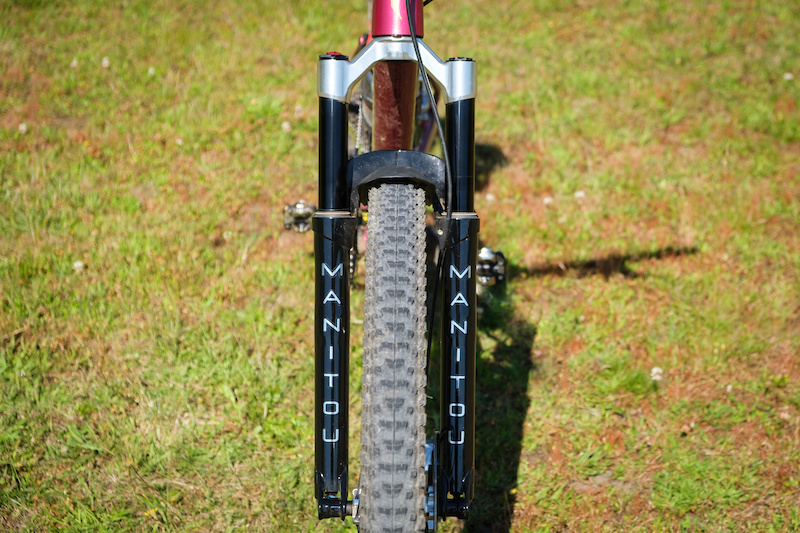Tech
First Ride: Manitou’s New R8 XC Fork – Pinkbike

The R8 is a dedicated cross-country fork, with 80 to 120 mm of travel (adjustable in 10mm increments), but the overall stiffness compared to its predecessor, the R7, has been increased thanks in part to the use of 34 mm stanchions. Modern race courses have become increasingly technical, and a stiffer chassis combined with a good damper can make a big difference when it comes to comfort and control.
• Travel: 80-120mm
• Wheel size: 29″
• 44mm offset
• 34mm stanchions
• Damper: VTT Pro-X
• Air spring: Dorado Air w/ IVA XC
• Weight: 1484 grams
• Price: $1,000 – $1,1000 USD
• manitou.com
The R8 has a three position compression dial, and is also available with a handlebar mounted remote. The remote-equipped version is $1,100, and the non-remote version is $1,000. With the axle installed, my 120mm test fork weighed in at 1484 grams; the fender and hardware will add 39 grams to that number.
Details
Manitou has packed an impressive amount of damping technology into the R8. In many cases, XC forks are extra-pared down versions of a company’s trail and enduro offerings, and niceties like the ability to fine tune the amount of low speed compression get left behind in the name of weight savings. The R8 goes against that trend, thanks to the design of the VTT Pro-X damper. It has a three position compression dial with a smaller dial on top that’s used to adjust the amount of low speed compression in the open mode. The second position has more high- and low-speed damping than position one, and will likely see the most use. Position three is a full lockout, and I mean full – there’s almost zero fork movement, and it’s best suited for pavement or extra-smooth dirt roads.
While the air spring design was originally derived from the Dorado downhill fork, it’s been adapted for XC usage. The air valve is located on the bottom of the left leg, and during inflation the positive and negative air chambers are equalized simultaneously. Changing the amount of travel only requires clipping on or removing a plastic spacer, and all the spacers needed are included with the fork. The same goes for adjusting the amount of bottom out resistance – there are four spacers, and their position on the shaft that extends underneath the air spring side top cap determines the amount of end stroke ramp up.
Rebound is adjusted via a blue knob on the underside of the right leg, and there are 18 clicks to choose from.
Even with the move to 34 millimeter stanchions, the R8 weighs less than the R7 and its 32mm stanchions thanks to the use of a heavily machined crown, thin wall legs made from 7000 series aluminum, and a new thru-axle that weighs just 25 grams.
Ride Impressions
I installed a 120mm R8 on a Specialized Chisel (it was hiding in plain sight in the launch article for that bike), which has 110m of rear travel. I’ve been able to get in a solid handful of rides so far, with a good mix of trails that included smoother, faster singletrack, rough, root-filled sections, plus some moderate sized jumps and drops for good measure.
So far, it’s the well controlled damping that’s impressed me the most. On a shorter travel fork achieving a good balance between support and comfort can be tricky, since there aren’t as many millimeters of travel to play with. With the R8, I’ve been very happy with it in the middle compression position for almost all of my riding – that gives a good platform to push against when climbing out of the saddle or sprinting on the flats, while still remaining supple enough to deal with chattery sections of trail. It also handles with bigger hits well, and the couple of bottom out events I’ve had were most definitely deserved.
My only gripe at the moment has to do with the noisiness of the damper – it makes an audible squelching sound on the rebound stroke that’s much louder than what you’d hear on a Fox 34 or RockShox SID. I’ve started to get used to it, but I’d still rather it was totally quiet. The noise does vary depending on where the rebound is set – at 0 to 11 clicks from closed it’s quite loud, but it does reduce as the damper is opened up further, and is much less noticeable for the remaining 7 possible rebound positions.
According to Manitou, “The VTT Pro-X damper in the R8 uses an 8mm shaft with corresponding diameters in the sealed cartridge, our trail and enduro dampers use a 10mm shaft. Due to the smaller sizes there are higher internal operating pressures that require the shims to flow more oil to achieve the same level of traction Manitou is well regarded for. The “woosh” noise is a result of the higher oil velocity through the shims to maintain the similar rebound speeds as our 10mm dampers, the noise is typically only present when the rebound setting is more closed. The noise has no effect on performance and will only be present for certain riders who are running a slower rebound setting.”
Suspension noises are sort of like hub noises – for some riders the louder the better, but for me, I want things as close to silent as possible. Okay, the fender could also be stiffer, but it hasn’t made any noise just yet (or maybe I can’t hear it over the sound of the damper).
I’ll be experimenting different settings as the review progresses, but so far the R8 is off to a strong start when it comes to overall feel – its manners are closer to what you’d expect from longer travel trail fork, but in a short travel package that’s light enough for top level XC racing.


)






